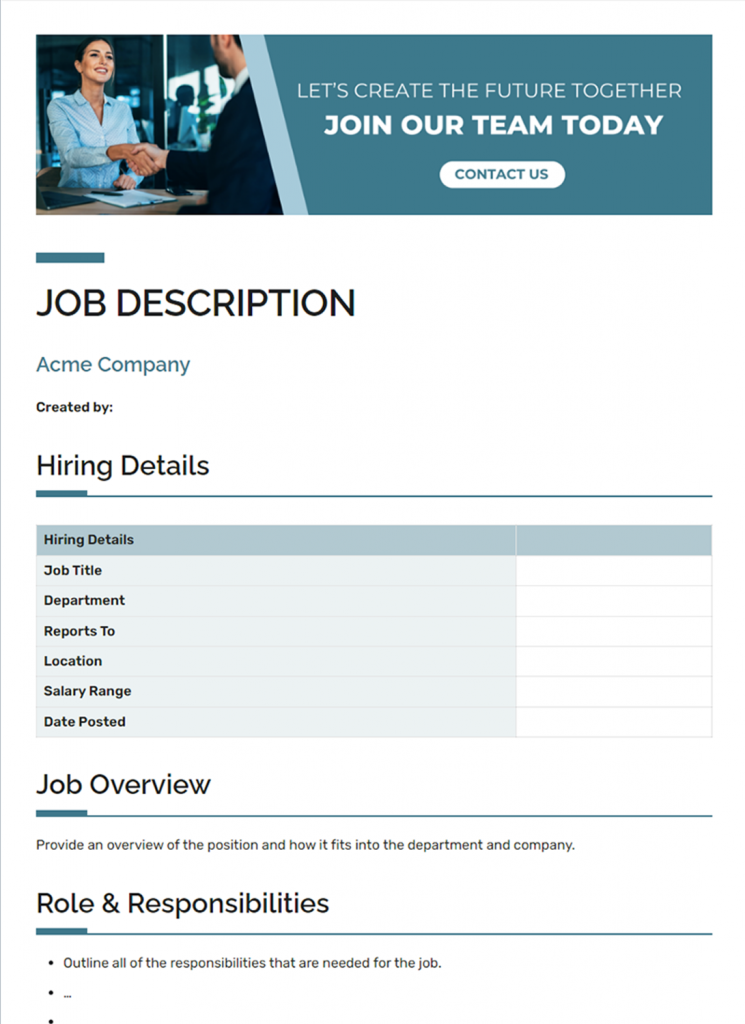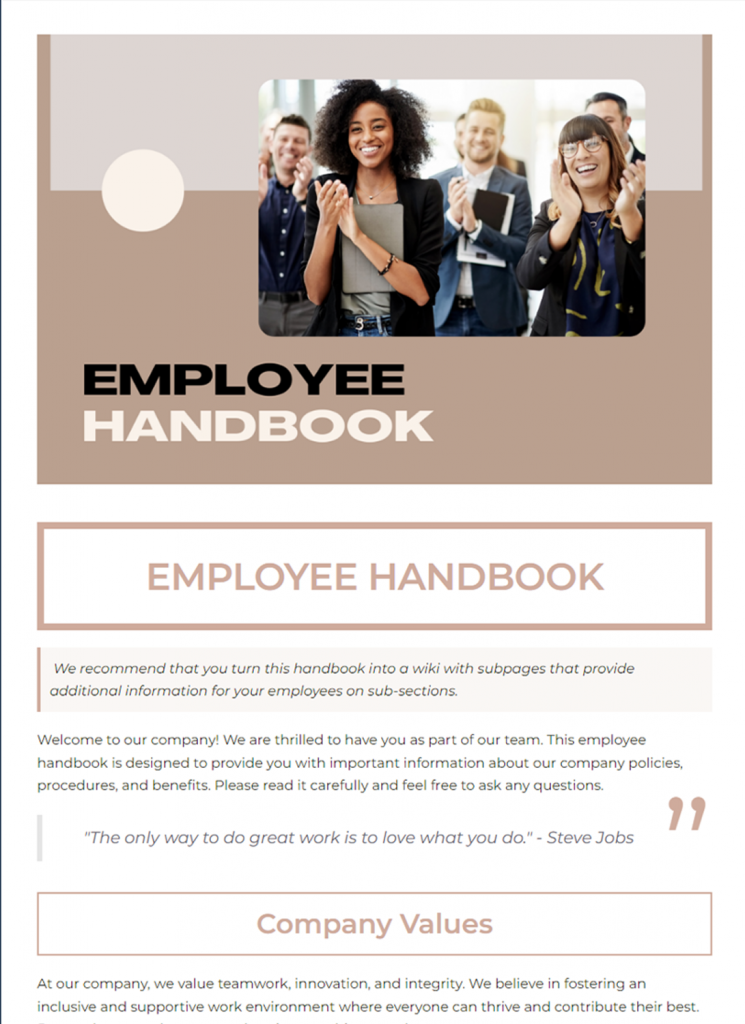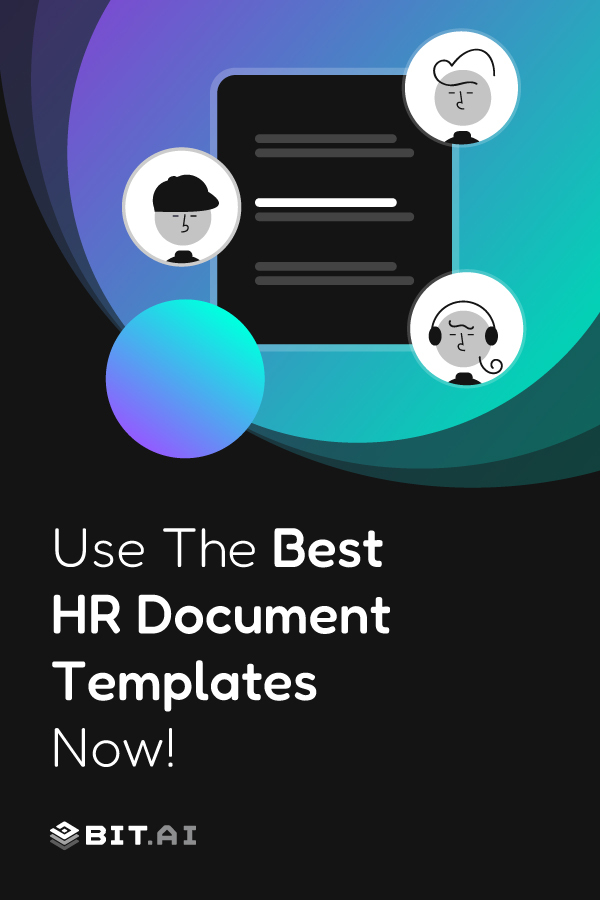Managing employees effectively is crucial for any successful business, and that’s where the human resources (HR) department comes in. HR is responsible for a wide range of tasks, from hiring and onboarding to managing payroll and employee relations. Each of these tasks requires specific documents.
Creating these documents takes time and precision, ensuring that they comply with legal standards and meet the company’s needs. It’s a challenging task, especially when you’re juggling multiple responsibilities. But what if you had access to a collection of HR document templates, ready to use and tailored to your needs? This would save you time, reduce errors, and help you maintain consistency across all HR functions.
We’ve compiled a list of essential HR document templates to help you align your processes. Whether you need forms for hiring, performance evaluations, or exit procedures, we have you covered. These templates are designed to make your HR tasks more manageable and efficient.
Explore our complete blog post where we dive into these essential HR documents and templates, providing you with the tools you need to build and oversee an effective HR department. Read on!
Top 20 HR Document Templates
Performing HR tasks effectively requires having the right documents for your help. From recruitment to termination, these essential documents align operations and ensure compliance. Creating these documents along with managing everything from hiring to payroll can be challenging, but the right templates can simplify the process. Explore our list of 20 must-have HR document templates to help you manage your HR responsibilities efficiently and effectively. Read on!
Recruitment and Onboarding
1. Job Descriptions
When you’re hiring, creating job descriptions is your first step. These documents outline what the job is, what the responsibilities are, and what skills and qualifications are needed. A well-written job description helps you attract the right candidates and sets clear expectations. It’s your way of communicating what you’re looking for in a candidate and what the job will involve on a day-to-day basis. To create an effective job description, you’ll need to include several key elements like:
- Job Title: Clearly state the job title.
- Job Summary: Add a brief overview of the role and its purpose.
- Responsibilities: List the main tasks and duties of the position.
- Qualifications: Specify the education, skills, and experience required for the job.
- Salary and Benefits: Provide an idea of the compensation and benefits package.
- Reporting Line: Indicate who the employee will report to.
- Location and Working Condition: State where the job is based and the work environment details.
- Company Overview: Briefly describe your company and its culture.


2. Offer Letter
Once you’ve found the right candidate, the next step is the offer letter. This document officially offers the job to your chosen candidate and outlines the main terms of employment. It’s your opportunity to formally welcome the candidate to your team and provide them with the details they need to make an informed decision about joining your company. The offer letter should include these important points to ensure clarity and transparency:
- Job Title and Description: Confirm the position being offered.
- Start Date: Specify when the candidate is expected to start.
- Salary: Detail the offered salary and payment frequency.
- Benefits: Outline the benefits package, including health insurance, retirement plans, and any perks.
- Work Schedule: Indicate the expected work hours and days.
- Reporting Line: Mention who the new hire will report to.
- Conditions of Employment: Include any conditions such as background checks or privacy policies.
- Expiration Date: State the deadline for the candidate to accept the offer.
Read More: Top Challenges in Employee Relations and How to Overcome Them


3. Employment Contract
The employment contract is your formal agreement with your new employee. This legal document goes beyond the offer letter, outlining all the terms and conditions of employment in detail. It’s designed to protect both you and the employee by clearly setting out the rules and expectations for the working relationship. Here’s what you need to address in an employment contract:
- Job Title and Description: Define the role and main responsibilities.
- Start Date and Duration: Indicate when employment begins and if it is permanent or temporary.
- Salary and Benefits: Specify the salary, bonuses, and benefits.
- Work Hours and Location: State the expected work hours and where the employee will work.
- Probation Period: If applicable, outline the probationary period and its terms.
- Duties and Responsibilities: Clearly list the tasks and duties expected.
- Confidentiality and Non-Compete Clauses: Protect your company’s sensitive information.
- Termination Conditions: Define the conditions under which the employment can be terminated by either party.
- Dispute Resolution: Outline how disputes will be handled.
4. Job Agreement
When you’re bringing a new team member on board, a job agreement is crucial. This document is similar to an employment contract but can be simpler and more flexible, outlining the terms and conditions of employment in a clear and concise manner. It’s designed to ensure both you and your employee understand the commitments and expectations involved. In creating a job agreement, you’ll need to include various key details to make everything clear and official. Here’s what should be covered:
- Job Title and Description: Clearly state the position and main duties.
- Compensation: Detail the salary, payment schedule, and any bonuses.
- Work Hours: Specify the expected working hours and schedule.
- Start Date: Indicate when the employee will begin working.
- Duration of Employment: Note whether the position is permanent, temporary, or on a contract basis.
- Benefits: Outline the benefits offered, such as health insurance and retirement plans.
- Confidentiality: Include clauses to protect company information.
- Termination Terms: Define the conditions under which employment can be ended.
5. New Employee Checklist
Onboarding a new hire involves many steps, and a new employee checklist helps you keep track of all the necessary tasks. This document ensures that you don’t miss any important steps in welcoming and integrating your new team member, from administrative tasks to introductions and training. To create a comprehensive new employee checklist, you’ll need to include several key tasks and items like:
- Pre-Arrival Preparation: Set up the workspace, arrange equipment, and prepare necessary documents.
- First Day Orientation: Welcome the new hire, provide an office tour, and introduce them to the team.
- Paperwork Completion: Ensure all required forms, such as tax documents and direct deposit information, are filled out.
- Training and Development: Schedule training sessions and provide access to necessary resources.
- Policy Review: Go over company policies, procedures, and the employee handbook.
- IT Setup: Ensure email accounts, software access, and other IT needs are set up.
- Health and Safety: Cover emergency procedures, safety guidelines, and related protocols.

6. Orientation Schedule
When a new employee joins your company, an orientation schedule is essential. This document outlines the plan for the new hire’s first few days or weeks, providing a structured introduction to your company, its culture, and their role. By following a well-structured orientation schedule, you ensure that your new employee starts off on the right foot, fully prepared and engaged. To design an effective orientation schedule, you’ll need to cover:
- Welcome Meeting: Start with a session to greet the new hire and provide an overview of the orientation plan.
- Company Overview: Present information about the company’s history, mission, values, and culture.
- Departmental Introduction: Introduce the new hire to key departments and colleagues they will be working with.
- Role-Specific Training: Provide detailed training on job responsibilities and necessary skills.
- HR Policies: Review important policies, including attendance, dress code, and conduct.
- Benefits Overview: Explain the employee benefits package and how to enroll in various programs.
- Health and Safety Training: Cover workplace safety protocols and emergency procedures.
- Q&A Session: Allow time for the new hire to ask questions and clarify any doubts.
Read More: Best Team Engagement Activities To Energize Your Workplace
Employee Records and Administration
7. Employee Records
Keeping thorough employee records is vital for managing your workforce effectively. These records store important information about each employee, from their personal details to performance evaluations. Well-maintained employee records help you comply with legal requirements and manage HR tasks more efficiently. When organizing employee records, several key elements should be included to ensure completeness and accuracy. Here’s what to include:
- Personal Information: Employee’s full name, contact details, and emergency contacts.
- Employment History: Job titles, dates of employment, and previous roles.
- Performance Reviews: Documentation of performance evaluations and feedback.
- Salary and Benefits: Details of salary history, bonuses, and benefits enrollment.
- Training and Development: Records of training sessions, certifications, and skills development.
- Disciplinary Actions: Documentation of any disciplinary actions taken and their outcomes.
- Attendance Records: Information on leaves, absences, and punctuality.
- Legal Documents: Copies of contracts, non-disclosure agreements, and other legal forms.
8. Expense Reimbursement Form
Handling employee expenses efficiently is crucial for smooth financial management. An expense reimbursement form is used by employees to claim back money spent on business-related expenses. This form ensures that the process is transparent and that all claims are accurately tracked. Creating an expense reimbursement form involves incorporating:
- Employee Information: Full name, department, and contact details.
- Expense Details: Date, description, and purpose of each expense.
- Amount: The total amount spent on each item or service.
- Receipts: Attachments or references to receipts for each expense.
- Approval Signatures: Space for the employee and the manager to sign off on the form.
- Account Codes: Designations for internal accounting purposes.
- Submission Date: The date the form is submitted for reimbursement.

9. Payroll Records
Accurate payroll records are essential for managing your employees’ pay and ensuring compliance with tax laws. These records document all payments made to employees, including wages, bonuses, and deductions. Proper payroll management helps you avoid errors and meet legal obligations. To maintain thorough payroll records, include these key components:
- Employee Details: Full name, employee ID, and contact information.
- Pay Periods: Dates for each pay period and corresponding payment dates.
- Gross Wages: Total earnings before deductions.
- Deductions: Itemized list of taxes, benefits contributions, and other deductions.
- Net Pay: Amount paid to the employee after deductions.
- Overtime: Records of any overtime hours worked and payments.
- Bonuses and Commissions: Documentation of additional earnings beyond regular wages.
- Tax Information: Details of tax withholdings and employer tax contributions.
10. Statutory Documents
Managing statutory documents is crucial for legal compliance and smooth business operations. These documents include all necessary legal forms and filings required by government agencies. Properly handling statutory documents ensures you meet your legal obligations and avoid penalties.
To manage statutory documents effectively, include these essential forms and records:
- Tax Filings: Copies of tax returns, quarterly tax payments, and other tax-related documents.
- Employee Contracts: Legally binding agreements between the company and employees.
- Regulatory Filings: Documents required by industry-specific regulations or standards.
- Health and Safety Reports: Records of compliance with workplace safety laws and inspections.
- Corporate Governance: Documents related to the structure and governance of the company, such as board meeting minutes.
- Licenses and Permits: Copies of business licenses, permits, and certifications.
- Insurance Policies: Documentation of various insurance policies held by the company.
Company Policies and Procedures
11. Employee Handbook
Your employee handbook is an essential document that provides a comprehensive guide to your company’s policies, procedures, and culture. This document sets the standard for what is expected from employees and what they can expect from you as their employer. It helps create a clear understanding of the workplace rules and fosters a positive work environment. Here’s what you should cover in an employee handbook:
- Introduction: Welcome note and overview of the company’s mission, vision, and values.
- Employment Policies: Details about hiring, probation, and termination processes.
- Compensation and Benefits: Information on salaries, bonuses, health insurance, and retirement plans.
- Work Hours and Attendance: Policies on work schedules, breaks, and attendance requirements.
- Code of Conduct: Guidelines on behavior, dress code, and use of company property.
- Leave Policies: Details on vacation, sick leave, and other types of leave.
- Health and Safety: Information on workplace safety procedures and emergency protocols.
- Performance Management: Overview of performance reviews and career development opportunities.
- Disciplinary Procedures: Steps for addressing misconduct or policy violations.


12. Code of Conduct
Establishing a code of conduct is crucial for setting the standards of behavior within your company. This document outlines the principles and ethical standards that employees are expected to adhere to. It helps promote a respectful, safe, and productive work environment by defining acceptable and unacceptable behaviors. Creating an effective code of conduct involves addressing:
- Introduction: Statement of the company’s commitment to ethical behavior.
- Respectful Workplace: Guidelines on treating colleagues with respect and avoiding discrimination and harassment.
- Integrity and Honesty: Expectations for honesty in communications and business practices.
- Confidentiality: Rules for protecting company and client information.
- Conflict of Interest: Policies on avoiding conflicts between personal interests and company interests.
- Use of Company Resources: Guidelines for the appropriate use of company property and resources.
- Compliance with Laws: Commitment to following all applicable laws and regulations.
- Reporting Violations: Procedures for reporting unethical behavior or policy violations.
- Disciplinary Actions: Consequences for failing to adhere to the code of conduct.
13. Workplace Safety Checklist
Ensuring a safe work environment is paramount, and a workplace safety checklist is a practical tool to achieve this. This document helps you identify and address potential hazards, ensuring compliance with safety regulations and promoting the well-being of your employees. Regular use of a safety checklist can prevent accidents and create a culture of safety within your organization. To develop a comprehensive workplace safety checklist, you need to include:
- General Workplace Conditions: Check for cleanliness, proper lighting, and clear walkways.
- Emergency Exits: Ensure exits are clearly marked and unobstructed.
- Fire Safety: Verify the presence and accessibility of fire extinguishers and alarms.
- First Aid: Confirm that first aid kits are stocked and easily accessible.
- Equipment Safety: Inspect machinery and equipment for proper functioning and safety guards.
- Chemical Safety: Ensure safe storage and labeling of hazardous materials.
- Personal Protective Equipment (PPE): Check availability and use of necessary PPE.
- Ergonomics: Assess workstation setups to prevent strain and injury.
- Training and Drills: Ensure employees are trained on safety procedures and emergency response.

Read More: Remote Employee Onboarding Checklist and Best Practices!
Here’s a simple checklist table for easy reference:
- Workplace cleanliness
- Emergency exit clear
- Fire extinguishers accessible
- First aid kits stocked
- Machinery safety guards in place
- Hazardous materials labeled
- PPE available and used
- Ergonomic workstations
- Employee safety training completed
14. Remote Work Agreement
Adopting remote work in your company requires a clear remote work agreement. This document outlines the terms and conditions for employees working from home or another remote location. It helps set expectations and ensures both you and your employees understand the guidelines and responsibilities involved in remote work. To create a comprehensive remote work agreement, several important points should be covered like:
- Employee Information: Full name, position, and department.
- Remote Work Schedule: Details of working hours and days, and any flexibility allowed.
- Work Location: Approved remote work location(s) and any specific requirements.
- Communication Protocols: Expectations for availability, response times, and communication tools to be used.
- Equipment and Technology: List of company-provided equipment and technology support.
- Data Security: Guidelines for ensuring the security and confidentiality of company data.
- Performance Expectations: Criteria for measuring productivity and performance while working remotely.
- Compensation and Benefits: Confirmation that salary and benefits remain unchanged, unless otherwise stated.
- Termination of Agreement: Conditions under which the remote work agreement can be altered or terminated.
15. Time-Off Request Form
Managing time-off requests efficiently is crucial for maintaining workflow and employee satisfaction. A time-off request form is a standardized document that employees use to request leave. It helps you track and approve time-off requests systematically, ensuring that staffing levels are maintained. Create an effective time-off request form by adding:
- Employee Information: Full name, position, and department.
- Date of Request: The date the form is filled out.
- Type of Leave: Specify whether it’s vacation, sick leave, personal leave, or other types.
- Leave Dates: Start and end dates of the requested time off.
- Reason for Leave: An optional field for employees to provide a reason.
- Supervisor’s Approval: Space for the supervisor to approve or deny the request.
- Signature: Areas for the employee and supervisor to sign and date the form.
Here’s a simple form template for easy reference:
| Time-Off Request Form |
| Employee Information |
| Name: ____________________________ |
| Position: _________________________ |
| Department: ______________________ |
| Date of Request |
| Date: ____________________________ |
| Type of Leave |
| Vacation: ____ Sick: ____ Personal: ____ |
| Other (specify): _______________ |
| Leave Dates |
| Start Date: ______________ End Date: _______ |
| Reason for Leave (optional) |
| ____________________________________________ |
| Supervisor’s Approval |
| Approved: ____ Denied: ____ |
| Supervisor’s Signature: _______________ |
| Employee’s Signature |
| Employee’s Signature: _______________ |
Read More: 15 Employee Management Software for 2025: A Quick Guide!
Performance and Development
16. Goal Setting
Establishing clear goals is vital for driving performance and ensuring that your team is aligned with the company’s objectives. A goal-setting document helps you and your employees set, track, and achieve targets effectively. This process not only clarifies expectations but also motivates employees by providing them with a clear direction and purpose. To draft an effective goal-setting document, consider the following:
- Employee Information: Name, position, and department.
- Goal Overview: Description of the specific goals to be achieved.
- SMART Criteria: Ensure goals are Specific, Measurable, Achievable, Relevant, and Time-bound.
- Action Plan: Detailed steps and strategies to achieve each goal.
- Resources Needed: Identify any tools, training, or support required.
- Timeline: Start and end dates for each goal, including key milestones.
- Progress Tracking: Methods for monitoring progress and adjusting plans as needed.
- Evaluation Criteria: Standards for measuring success and completion of goals.
- Signatures: Spaces for the employee and supervisor to acknowledge and commit to the goals.

17. Performance Appraisal
Evaluating employee performance is crucial for growth and development. A performance appraisal document allows you to assess an employee’s work, provide constructive feedback, and set future goals. This process helps improve productivity, recognize achievements, and address areas needing improvement. A comprehensive performance appraisal document involves:
- Employee Information: Name, position, and department.
- Review Period: Dates covered by the appraisal.
- Performance Summary: Overview of the employee’s overall performance during the review period.
- Achievements: Specific accomplishments and contributions made by the employee.
- Areas for Improvement: Constructive feedback on where the employee can improve.
- Goal Review: Assessment of previously set goals and their outcomes.
- Future Goals: New goals and objectives for the next review period.
- Training and Development Needs: Identification of any training or development opportunities.
- Employee Feedback: Add a section for the employee to provide their input and comments.
- Signatures: Add spaces for both the employee and the reviewer to sign and date the document.
Employee Relations and Exit Procedures
18. Disciplinary Action Form
Maintaining discipline in the workplace is essential for a harmonious and productive environment. A disciplinary action form is used to document incidents where an employee’s behavior or performance does not meet company standards. This form helps ensure that disciplinary processes are fair, consistent, and properly recorded. When creating a disciplinary action form, several key elements should be included to ensure clarity and completeness. Here’s what to cover:
- Employee Information: Name, position, and department.
- Date of Incident: When the behavior or performance issue occurred.
- Description of Incident: Detailed account of what happened, including specific actions or behaviors.
- Policy Violations: Reference to the specific company policies or rules that were violated.
- Previous Warnings: Any prior warnings or disciplinary actions related to the same issue.
- Disciplinary Action Taken: Description of the action taken, such as a verbal warning, written warning, suspension, or termination.
- Employee’s Response: Space for the employee to provide their perspective or explanation.
- Action Plan: Steps the employee must take to correct the issue.
- Signatures: Spaces for both the employee and the supervisor to sign and date the form.
Here’s a simple form template for easy reference:
| Disciplinary Action Form |
| Employee Information |
| Name: ____________________________ |
| Position: _________________________ |
| Department: ______________________ |
| Date of Incident |
| Date: ____________________________ |
| Description of Incident |
| ____________________________________________ |
| Policy Violations |
| ____________________________________________ |
| Previous Warnings |
| ____________________________________________ |
| Disciplinary Action Taken |
| ____________________________________________ |
| Employee’s Response |
| ____________________________________________ |
| Action Plan |
| ____________________________________________ |
| Signatures |
| Employee: _________________________ Date: ______ |
| Supervisor: _______________________ Date: ______ |
19. Grievance Complaint Form
Addressing employee concerns effectively is key to maintaining a positive work environment. A grievance complaint form allows employees to formally raise issues or concerns about their working conditions, colleagues, or company policies. This form ensures that grievances are documented and addressed systematically. For creating an effective grievance complaint form, cover these points:
- Employee Information: Name, position, and department of the employee.
- Date of Complaint: When the grievance is being filed.
- Description of Grievance: Detailed account of the issue or concern.
- Parties Involved: Names of individuals involved in or related to the grievance.
- Impact of Grievance: Explanation of how the issue affects the employee or workplace.
- Previous Actions Taken: Any steps already taken to address the grievance.
- Desired Outcome: What the employee hopes to achieve by filing the complaint.
- Supporting Documents: Any relevant documents or evidence supporting the grievance.
- Signatures: Spaces for the employee and HR representative to sign and date the form.
Here’s a simple form template for easy reference:
| Grievance Complaint Form |
| Employee Information |
| Name: ____________________________ |
| Position: _________________________ |
| Department: ______________________ |
| Date of Complaint |
| Date: ____________________________ |
| Description of Grievance |
| ____________________________________________ |
| Parties Involved |
| ____________________________________________ |
| Impact of Grievance |
| ____________________________________________ |
| Previous Actions Taken |
| ____________________________________________ |
| Desired Outcome |
| ____________________________________________ |
| Supporting Documents |
| ____________________________________________ |
| Signatures |
| Employee: _________________________ Date: ______ |
| HR Representative: ________________ Date: ______ |
20. Exit Documents
Managing the departure of an employee requires careful handling of exit documents. These documents are essential for ensuring a smooth transition and addressing any outstanding issues. They help you formalize the end of employment, retrieve company property, and provide necessary information to the departing employee. To create detailed exit documents consider adding:

- Resignation/Termination Letter: Formal letter acknowledging the employee’s resignation or termination.
- Exit Interview Form: Questions to gather feedback about the employee’s experience and reasons for leaving.
- Final Pay Details: Information on final salary, accrued benefits, and any outstanding payments.
- Return of Company Property: Checklist for retrieving company assets such as keys, ID cards, laptops, and phones.
- Benefits Information: Details on the continuation of benefits, such as health insurance or retirement plans.
- Confidentiality Agreement: Reminder of any confidentiality or non-compete agreements still in effect.
- References and Contacts: Information on who to contact for references or employment verification.
- Signatures: Spaces for both the employee and the HR representative to sign and date the documents.
Conclusion
Here, we’ve reached the end of our discussion on HR document templates. You’ve learned a lot about the essential forms needed for managing various HR tasks, from recruitment to termination. These templates are designed to make your HR processes smoother, legally compliant, and consistent. Using them will save you time, reduce errors, and improve the overall employee experience.
As you implement these templates, remember to regularly update them and train your HR team on how to use them effectively. So, what are you waiting for? Dive into these templates and boost your HR operations today!
Further Reads:
Boost Employee Morale with these Effective Tips!
The Benefits & Drawbacks of Working Remote (WFH)
How To Write a Daily Activity Report? (Steps,Key Elements & Benefits)
How to Create Wikis for Employee Onboarding & Training?


